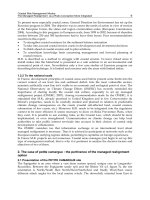Construction delays chapter seventeen delay—risk management
Bạn đang xem bản rút gọn của tài liệu. Xem và tải ngay bản đầy đủ của tài liệu tại đây (1.05 MB, 14 trang )
CHAPTER SEVENTEEN
Delay—Risk Management
The construction process is one that includes considerable risks. One of
the greatest areas of risk is time and the associated costs of delay. A successful project requires that the risks associated with time are well managed. By recognizing the risks that exist and planning for these by
properly modeling them in the project schedule, these potentially costly
risks can be minimized and controlled.
The companion of good planning and scheduling is good project documentation. The analytical processes presented in this book, which will
enable project managers to identify risks early and adjust for them efficiently, cannot be performed if good documentation does not exist. At
the top of the list are daily reports, which are enhanced by photographs
and videos taken periodically over the course of the project. Detailed
documentation of costs must also be maintained in a way that, as much as
practicable, allows for segregation to discrete issues.
OWNER’S CONSIDERATIONS
Owners should begin to evaluate the potential risks associated with
the duration of the project during the feasibility studies and initial planning stages of the project. One of the initial considerations of the owner
is the external constraints concerning time. For example, does the facility
need to be completed by a certain date to meet a critical production
need, or for political reasons? These factors influence the way in which
the owner pursues the project. Certain time requirements and needs may
indicate that a fast-track approach to the project is required. The owner
must consider the realities of finishing the project within the required
time frame. Merely because external considerations require that a project
be completed by a certain date does not mean that the project can, in
fact, be completed by that date. The owner should consult with knowledgeable advisors to determine a reasonable project duration to specify in
the contract documents. Bidders should themselves thoroughly investigate
Construction Delays.
DOI: />
Copyright © 2018 Trauner Consulting Services, Inc.
Published by Elsevier Inc. All rights reserved.
341
342
Construction Delays
the time constraints, but it is always best for the owner to point out any
special considerations up front. For example, if the required duration can
only be achieved by an accelerated effort, such as multiple shifts and 7day work weeks, the potential need for these elements should be stated in
the contract or at least discussed during the prebid meeting. The owner is
far better off alerting bidders to the anticipated urgency at which the
project will need to be constructed.
Scheduling clauses
To control and manage the project’s duration, the contractor must have a
reliable schedule that is shared with the owner. To ensure that the desired
schedule is used, the contract should specify the requirements for both a reliable schedule and periodic updates. Depending on the owner’s degree of participation, different scheduling requirements may be dictated by the contract.
Scheduling clauses should include the requirement to provide a baseline
schedule before work will commence. The baseline schedule should be
due within a prescribed period of time and there should be a specific time
period for owner’s review. These requirements often appear in contracts
but enforcement varies greatly. As with any provisions, unenforced scheduling provisions accomplish nothing. An owner could consider allowing the
contractor to submit a basic schedule to get the project started, but require
more detail within a prescribed time frame. The same should be true of
updates; there should be specific requirements about when to submit them
and the submission should be tied to progress payments.
The scheduling clause may or may not require manpower, equipment,
and cost loading. While this type of information may be useful to both
the contractor and the owner, the owner should carefully consider if the
benefits are worth the effort. Clearly, having resource and cost loading in
a schedule allows for more precise tracking of progress and a means for a
more objective evaluation of payment requests, but these enhancements
complicate the schedule and can lead to confusion and other problems. It
may be just as beneficial for the owner to specify a basic Critical Path
Method (CPM) schedule with no resource loading but with the ability to
require the contractor to submit such information for specific activities at
the request of the owner.
A sample scheduling specification is provided in the last chapter of this
book.
Delay—Risk Management
343
Liquidated damages clauses
When the contract is being prepared, the owner should also decide
whether to include a liquidated damages clause. In doing so, the owner
should carefully consider the potential damages if the project is delayed.
When drafting liquidated damage provisions, the owner should determine
not only the amount of potential damages that it may incur if the project
were to be completed late, but also whether there are anticipated damages
associated with any interim milestones that may be missed and if those
should be liquidated in the contract, as well.
Disputes clauses
The owner should also establish time limits in the contract for the filing
of claims by the contractor. The contract should clearly specify that claims
for additional compensation must be submitted to the owner within a set
number of days after the commencement of the event that gave rise to
the claim. A period of between 30 and 90 days is a common time frame
for the submission of claims. The clause should further state that if the
required claim information is not submitted within the time specified,
then the contractor forfeits the right to recover any additional compensation. While this is a useful provision, the enforceability of such a clause
may depend on the case law in your specific jurisdiction.
Not only should the contract specify a time limit for the filing of
claims, but it also should specify exactly what information must
be included in the contractor’s submission. Such information should
include:
• A clear narrative of what the claim is with references to attached
documents.
• An explanation of why the claim item differs from the work already
required by the contract.
• References to the specific contract clauses that apply.
• An explanation of the cause (or liability) for the claim.
• A clear definition of the specific impacts associated with the claim
(i.e., extra work, overtime, delay, etc.).
• A detailed breakdown of the damages or extra costs with supporting
information that relate to each claim issue.
A sample clause addressing claims is shown in Fig. 17.1.
344
Figure 17.1 Sample claims clause.
Construction Delays
Delay—Risk Management
345
Figure 17.1 (Continued).
Change order clauses
During the course of the project, the owner must carefully monitor and
manage change orders. Every change order has two parts, time and
money, and every change order should state whether or not additional
time is warranted. This task is far easier if an up-to-date CPM schedule is
maintained throughout the project that can be used to make a reliable
determination of delay for every change order.
Delay damages clauses
Another risk for the owner is the liability for delay damages. The owner
can insert a no-damage-for-delay clause in the contract, thus attempting
to shift the burden of the risk for delays to the contractor. However, the
use of this type of exculpatory language may increase the amounts bid by
the contractors bidding on the work and there is still no guarantee that a
dispute over delay damages will be prevented. The owner should research
the use of a no-damage-for-delay clause with qualified counsel before
including it in the contract as they may also be unenforceable in certain
jurisdictions.
An alternative approach is to specify limits to what types of damages
are allowable in the event of a delay. Some government agencies use this
approach.
Construction Delays
346
CONSTRUCTION MANAGER’S CONSIDERATIONS
Some projects include a construction manager, typically abbreviated
by the letters “CM.” The CM can be hired by the owner as its construction representative, in which case the CM is responsible for representing
the owner and protecting the best interests of the owner. This arrangement is typically called “agency CM.”
In other cases, the CM may have a financial interest in the project and
may be performing the project at a preestablished maximum cost, often
called a “guaranteed maximum price,” or GMP. The CM may be working
in a GMP arrangement with some sharing of the savings below the GMP.
These types of arrangements are often called “CM at risk” or “CMAR.”
Other variations in the relationships between the owner and the CM
or the CM and the contractors exist, but the discussion of these relationships is beyond the scope of this book. More details about these arrangements can be found at the website of the Construction Management
Association of America at cmaanet.org or the Design Build Institute of
America at DBIA.org.
Construction manager and the project timetable
The CM’s considerations regarding time begin at the inception of the
project during the planning phase. The CM must ensure that the overall
project schedule includes adequate time for all parties to perform their
work, including time for the exchange of project performance information between the owner and designer during the design phase; for the
careful preparation of contract documents, including the clauses that
address schedule and time; for developing contractor or subcontractor
interest in the project; for the preparation of responsive bids; for the
owner to evaluate bids; and most importantly, for the project to be constructed under normal conditions.
The CM must manage all the project parties to make sure that the
project stays on schedule. Just as the contractor is typically responsible for
means and methods of construction, the CM is responsible for the means
and methods to monitor and manage the performance of all the parties
including the evaluation of delays.
Some project parties may not be used to strict time management by
the CM. The CM must ensure that the contract language for all the parties includes time management provisions and procedures.
Delay—Risk Management
347
Even with the best planning, delays might occur. The CM must be
able to foresee delays and take proactive measures to mitigate or recover
from delays.
Often, project delays will be caused by the performance or lack
of performance of one or more of the project participants. The CM
must keep detailed and accurate records of the performance of all the
parties so that it can evaluate liability for delays. Once again, the CM is
expected to be the expert during the project who has the responsibility
to sort out project delays for the benefit of all parties including
the owner.
Construction manager responsibility to contractors
and subcontractors
If the CM is in an “at-risk” arrangement, it is now responsible to the
owner for managing the construction and to the contractors and subcontractors for administering the contracts. In this case, again, the CM is seen
as the construction management expert that should be able to manage the
performance of the project parties. Detailed and accurate performance
records, clear contract provisions, and dispute resolution procedures must
be developed and maintained by the CM. However, a CM “at risk” functions much like a general contractor. Consequently, the owner must ensure
that its contract with the CM is appropriately structured so that the owner’s
risks are managed.
Construction manager responsibility for managing changes
Along with managing time and schedule, the CM must manage changes
and the change order process. Change orders must address the additional
cost of the changed work and the time required to perform the changed
work. By properly maintaining a current and up-to-date CPM schedule
and detailed performance records, and by seeking adequate information
from the contractors and subcontractors, the CM should be able to evaluate time extensions and additional costs. All too often, only additional
costs resulting from changes are addressed and additional time or time
extension requests are left out of the change order. The “postponing” or
“delaying” of the management and assessment of time is not recommended and usually results in unnecessary disputes. The CM should be
proactive in preventing this common problem.
Construction Delays
348
Construction manager responsibility for delay analysis
Construction projects involve many variables in terms of project needs,
the participants’ motivations, and the need to build a project under sometimes unpredictable circumstances.
As a result, it is not uncommon for project delays to be caused by a
combination of actions or lack of actions by more than one project party,
changes, or unforeseen conditions. Therefore, even with the best records,
it may be difficult to identify and evaluate responsibility for delays. Some
CMs may be more experienced than others with delay analysis and evaluation. It may be necessary to engage the services of a scheduling and delay
analysis specialist to augment the CM’s services and to assist the owner to
evaluate the delays on a project. If that is the case, it is recommended that a
schedule/delay consultant be retained as soon as a problem is perceived.
Construction manager responsibility for quality, safety,
and environment
The CM may also be retained as the owner’s representative for ensuring
quality project work, project safety, and/or compliance with environmental
regulations. Again, because the CM is expected to be the expert in construction and representative of the owner, the choice of CM should only
be made after careful consideration of previous experience in these areas.
Consideration should be given to the experience of the CM firm and the
credentials of the individuals that the CM commits to assign to the project.
GENERAL CONTRACTOR’S CONSIDERATIONS
Like the owner, the general contractor also must assess the risks of
delays to the contract completion. These considerations parallel those of
the owner, but from a different perspective.
Assess the time allowed in the contract
The contractor should assess the time allowed in the contract to perform
the work to determine if enough time is provided to perform the work
without the use of extraordinary resources. If necessary or if required to
do so as directed in its contract, the contractor must include in its bid the
cost for and additional or extraordinary effort, such as overtime, added
Delay—Risk Management
349
supervision, and additional or special equipment required to meet the
contract completion date.
Assess exculpatory language
If the contract contains exculpatory language, especially in the area of nodamages-for-delay, the contractor should carefully consider accepting the
risks involved. Some projects are not worth the risk of bidding. The contractor should consult with qualified counsel before entering into a highly
restrictive contract with exculpatory language. Again, if the risk is too
great, the contractor may consider not bidding on the project or pricing
in the risk accordingly.
Not only must contractors assess the risk of exculpatory language in a
contract, but they must also read, understand, and comply with the contract provisions, particularly with respect to changes and claims. For
instance, the contract may specify a time limit for issuing a notice of a
change or for filing a claim. The contractor must comply with these
requirements. Also, the contractor should make sure to submit all information and documentation required by the contract.
Critical path method schedules
CPM schedules required by owners on projects can be effective tools for
managing a project. Many contractors resisted using this time management tool for many years, but most professional builders now realize the
usefulness of these schedules. Aside from managing the work, the CPM
schedule, properly updated, has become the most respected and reliable
document for recording a project’s as-built history. Trying to recreate the
progress on a project, after it is completed, is far more laborious than
contemporaneously updating the project schedule.
CPM schedules consider not only time but also resources. It is the
efficient use of resources that will allow the contractor to maximize its
profits. If delays arise on the project, the CPM schedule is one of the
most effective tools that the contractor has to demonstrate the delays that
occurred to both critical and noncritical activities.
Risk to subcontractors
The general contractor may pass some of its project risk on to its subcontractors. The amount of risk and responsibility is dictated to some extent
by the terms of the contract. Passing risk to the subcontractors is not
Construction Delays
350
always as easy as including a general pass-through clause. This type of
clause incorporates by reference all the conditions of the general contract
into the subcontract agreement. For example, a subcontract may include
the following general language: “All of the conditions of the contract
between the owner and the general contractor are incorporated herein by
reference and are binding upon the subcontractor.”
With a general pass-through clause, if a subcontractor delays a project,
the damages assessed against the subcontractor may be limited to the liquidated damages amount specified in the general contract. Yet the general
contractor is liable for that same amount of liquidated damages to the
owner, plus its own additional costs.
For example, if the general contract has a Liquidated Damages amount
of $200 per calendar day, the incorporation by reference of the general
contract may effectively limit any subcontractor’s liability for delays to the
$200 per day. Yet, the damages to the general contractor may exceed that
amount. Therefore, the general contractor may not simply want to pass
through all of the prime contract provisions. Rather, it may want to
include language stating that if the subcontractor causes a delay, it can be
held liable for delay costs from the general contractor, including the liquidated damages to the owner and delay damages from other subcontractors.
Consider early finish
General contractors should try to complete projects earlier than the time
allowed in the contract. By reducing time on the site, the contractor reduces
its general conditions costs and thereby realizes greater profit. At the planning stage, the general contractor should approach every contract with the
intent of early completion. If the contractor plans to finish the project early,
the project schedule should so state. There is no sense in having two schedules on the job_one for the early completion (the actual schedule), and one
that is shown to the owner reflecting the full contract duration.
SUBCONTRACTOR’S AND SUPPLIER’S CONSIDERATIONS
Subcontractor considerations
Normally, the general contractor dictates the subcontractor’s schedule. At
times, the schedule requirements incorporated into subcontract agreements
Delay—Risk Management
351
may be undefined or unreasonable. For example, subcontract agreements
commonly state that the subcontractor will perform its work in accordance
with the general contractor’s schedule and will adjust accordingly so as not
to delay the project work. Since this statement leaves the work period
undefined, the subcontractor may have to accelerate its work for the entire
duration of the job.
Subcontractors can insist on a lot of things regarding their contracts,
but few subcontractors can expect much success with this. What the subcontractor does need to make clear is that it bid the project for the contract start and completion dates in the bid for its work. If asked upfront
to bid an accelerated schedule, this request needs to be documented in
the subcontract. The subcontractor will have its own idea of how long it
needs to perform the work, and if the general contractor requires a shorter duration or a work sequence that the subcontractor did not contemplate in its bid, the subcontractor should carefully examine its ability to
perform and request a contract increase before agreeing to a change in
the schedule.
Specific schedule
To reduce risks associated with acceleration costs, the subcontractor
should clearly communicate to the general contractor the time and schedule to which the bid applies. The subcontractor should insist that schedules be included in the terms of the subcontract agreement.
Contract language
Subcontractors should seriously consider whether to bid on contracts
with extensive exculpatory language that shifts the general contractor’s
risk to the subcontractor. As noted earlier, some projects are not worth
bidding. Many general contractors have their own specific contracts written to suit their interests and strongly resist any changes to the language.
A subcontractor should review the general contractor’s agreement before
bidding and find out if the general contractor is amenable to contract
changes. If not, then the subcontractor needs to make a decision to live
with the language and account for it in the bid, or not bid the project.
The subcontractor is better off knowing what it is getting into in advance
before spending the time and money to estimate the project, be the low
subcontractor bidder, and be faced with an onerous contract.
Construction Delays
352
Subcontractors must become thoroughly familiar with all clauses in
their contracts. For instance, it is common to see clauses that state that for
subcontractor claims, the general contractor will “pass through the claim
to the owner.” The subcontractor will accept whatever damages the general contractor is able to collect and will also share in any costs for litigation or arbitration. Clauses of this nature may not sound “fair,” but
they are common.
It is also common to see clauses that state that if the subcontractor is
delayed by another subcontractor, it must seek compensation directly
from that subcontractor. Obviously, the clause is not desirable and creates
legal problems for the subcontractor who suffers the loss, vis-a`-vis privity
of contract.
Clearly, the general contractor may not always be motivated to act in
the subcontractor’s best interests. Therefore, the subcontractor should
attempt to include the following in its agreement with the general
contractor:
• An equitable breakdown of awards or settlements for claims involving
more than just the respective subcontractor.
• The right to pursue damages only against the general, and not the
other subcontractors.
• Proportional legal and administrative costs in claims actions.
DESIGN CONSULTANT’S CONSIDERATIONS
Designer considerations
Normally, the designer provides input on the duration of the project.
Such observations should not be formed or communicated casually. It is a
subject that should be analyzed in a careful, detailed manner to determine
the time required to perform the work considering the type of construction, the local site subsurface conditions, and local geographical considerations, such as temperature variations and weather.
Designer as owner’s representative
Designers who act as the owner’s representative during construction
should require the contractor to submit a detailed schedule for construction. The designer then reviews the schedule submitted by the contractor
Delay—Risk Management
353
and monitors progress during construction. It is advisable to establish procedures ahead of time with the contractor for schedule monitoring.
Changes
If the designer, as the owner’s representative, makes a change to the project because of owner’s decisions or errors and omissions in the plans and
specifications, it should assess the time effect, if any, that results from that
change. Designers should resist the tendency to deny any time extension
simply because they fear it might negatively reflect upon them. If a
change necessitates a valid extension to the duration of the project, the
problem can be resolved much sooner and usually at far less cost if
assessed fairly and impartially as soon as it arises.
Being the project designer and the owner’s representative is a difficult
dual role because there is a perceived, if not an actual, conflict of interest.
Virtually all projects have design problems. This is one of the reasons construction contracts are unique in having a changes provision. If a contractor submits a change request because of a design problem, the designer
must take all necessary measures to ensure that its decisions are fair and
impartial.
REAL-TIME CLAIMS MANAGEMENT
On larger, time-sensitive construction programs, many forward
looking public agencies, private owners, and contractors have instituted
coordinated measures aimed at preempting and mitigating claims and disputes. These claims-focused risk management programs have proven to
be extremely cost effective.
For owners, program goals are established and monitored. These goals
can include initiatives to: (1) make each project “claim-resistant,” (2) mitigate potential cross-contract problems during construction, (3) remove
contract administration inconsistencies for multiple project programs, and
(4) facilitate the timely resolution of any claim issues.
For contractors, goals can include initiatives to: (1) implement best
practices for scheduling and change administration, (2) implement effective documentation practices, and (3) satisfy contract requirements for
changes, claims, and time extensions.
354
Construction Delays
In both cases, the effective handling of changes and claims calls for
advanced preparation and a coordinated strategy in four areas:
• Claim Avoidance
• Claim Mitigation
• Claim Evaluation
• Claim Resolution
The basic concept of Real-Time Claims Management is to establish,
before the project starts, a program that is aimed at identifying problems
as early as possible and resolving them as quickly as possible. It requires
that the project participants “war game” the project before it starts and
identify as many potential problem areas as they can. Once the potential
problem areas are identified, the participants then develop a game plan
and specific approaches to prevent these problems from occurring and to
manage them expeditiously if they do occur. The overall attitude is that
the project participants will resolve their problems rather than seek a resolution from a judge or jury.
In the context of delays, the Real-Time Claims Management
approach focuses on time-related areas of possible problems. As an example, the program should include the following:
• Type of schedules to be required by contract
• Independent review of all schedules and schedule updates
• Precise requirements for identifying time extensions associated with
changes timely
• Procedure for independent review of time extension requests
• Scheduled meetings dedicated to review of project progress and project schedules
• Independent review of initial analysis of changes and associated time
extension requests
The practice of Real-Time Claims Management has shown that having independent input, review, and analysis before and during the project
results in fewer problems and more expeditious resolution of problems.
Most often, independent assistance is required when a delay dispute goes
to arbitration or trial. But with that timing, the expertise applied becomes
a determination of liability and a measure of the delays. Applying the
same level of expertise much earlier becomes a tool for prevention and
resolution. This is a far more cost-effective approach to the problem of
construction delays.









